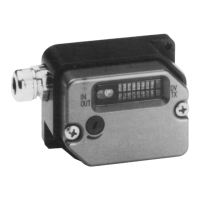
Do you have a question about the Leuze electronic DLSP 160S and is the answer not in the manual?
| Protection class | IP 67 |
|---|---|
| Operating voltage | 10-30 V DC |
| Connection | M12 plug connector, 5-pin |
| Switching output | PNP |
| Ambient temperature | -20...+60 °C |
| Storage temperature | -20°C to +70°C |
Explains symbols used in the technical description, including Danger, Notice, and cross-references.
Defines key terms like DLSP, DLSP 160S, AT 160xx, Tristate, and Semi-duplex.
States that DLSP 160 units comply with European standards and directives.
Details the DLSP's development, production, and testing according to applicable safety standards.
Describes permissible application areas and warns against misuse that could compromise safety.
Covers documentation, regulations, qualified staff, and maintenance requirements.
Describes DLSP as a no-contact device for electrical signal transmission.
Lists features like minimal space, rapid assembly, simple alignment, and simple commissioning.
Details housing, displays, setting, installation, and connection methods.
Explains transmission, signal transmission, receiving, data output, and data safety.
Explains setting transmit and receive addresses using DIP switches for parallel operation.
Describes how to store data outputs and the benefits of retaining output data.
Illustrates the signal profile from transmitter to receiver for a serial telegram.
Details non-contact data exchange for industrial trucks (AGVS) and fixed stations.
Explains parallel operation and addressing for extending transmission channels.
Describes how the DLSP can be used within bus systems.
Explains using the DLSP as a data storage device.
Lists technical specifications including manufacturer, transmission medium, range, and EMC.
Provides details on housing, dimensions, terminals, and protection class with diagrams.
Specifies the operating and storage temperature ranges for the DLSP.
Details supply voltage, current consumption, inputs, outputs, and maximum load.
Covers fastening the DLSP, preparing cables, and connecting them according to plug assignment.
Explains setting addresses, storage, performing tests, and adjusting sensitivity.